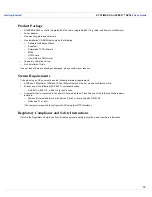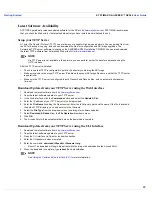
Introduction
SYSTIMAX® AirSPEED™ AP542
User Guide
14
SNMP Management
In addition to the HTTP and the CLI interfaces, you can also manage and configure an AP using the Simple Network
Management Protocol (SNMP). Note that this requires an SNMP manager program, like HP Openview or Castlerock’s
SNMPc. The AP supports several Management Information Base (MIB) files that describe the parameters that can be
viewed and/or configured over SNMP:
–
MIB-II (RFC 1213)
–
Bridge MIB (RFC 1493)
–
Ethernet-like MIB (RFC 1643)
–
802.11 MIB
–
AirSPEED Enterprise MIB
SYSTIMAX provides these MIB files on the CD-ROM included with each Access Point. You need to compile one or
more of the above MIBs into your SNMP program’s database before you can manage an Access Point using SNMP.
Refer to the documentation that came with your SNMP manager for instructions on how to compile MIBs.
The Enterprise MIB defines the read and read-write objects that can be viewed or configured using SNMP. These
objects correspond to most of the settings and statistics that are available with the other management interfaces. Refer
to the Enterprise MIB for more information; the MIB can be opened with any text editor, such as Microsoft Word,
Notepad, or WordPad.
SNMPv3 Secure Management
SNMPv3 is based on the existing SNMP framework, but addresses security requirements for device and network
management.
The security threats addressed by Secure Management are:
•
Modification of information
: An entity could alter an in-transit message generated by an authorized entity in such a
way as to effect unauthorized management operations, including the setting of object values. The essence of this
threat is that an unauthorized entity could change any management parameter, including those related to
configuration, operations, and accounting.
•
Masquerade
: Management operations that are not authorized for some entity may be attempted by that entity by
assuming the identity of an authorized entity.
•
Message stream modification
: SNMP is designed to operate over a connectionless transport protocol. There is a
threat that SNMP messages could be reordered, delayed, or replayed (duplicated) to effect unauthorized
management operations. For example, a message to reboot a device could be copied and replayed later.
•
Disclosure
: An entity could observe exchanges between a manager and an agent and thereby could learn of
notifiable events and the values of managed objects. For example, the observation of a set command that changes
passwords would enable an attacker to learn the new passwords.
To address the security threats listed above, SNMPv3 provides the following when secure management is enabled:
•
Authentication: Provides data integrity and data origin authentication.
•
Privacy (a.k.a Encryption): Protects against disclosure of message payload.
•
Access Control: Controls and authorizes access to managed objects.
The default SNMPv3 username is
administrator
, with SHA authentication, and DES privacy protocol.
SSH (Secure Shell) Management
You may also securely manage the AP using SSH (Secure Shell). The AP supports SSH version 2, for secure remote
CLI (Telnet) sessions. SSH provides strong authentication and encryption of session data.
The SSH server (AP) has
host keys
- a pair of asymmetric keys - a
private key
that resides on the AP and a
public
key
that is distributed to clients that need to connect to the AP. As the client has knowledge of the server host keys,
the client can verify that it is communicating with the correct SSH server.
NOTE
The remainder of this guide describes how to configure an AP using the HTTP Web interface or the CLI
interface. For information on how to manage devices using SNMP or SSH, refer to the documentation that
came with your SNMP or SSH program. Also, refer to the MIB files for information on the parameters available
via SNMP and SSH.





























